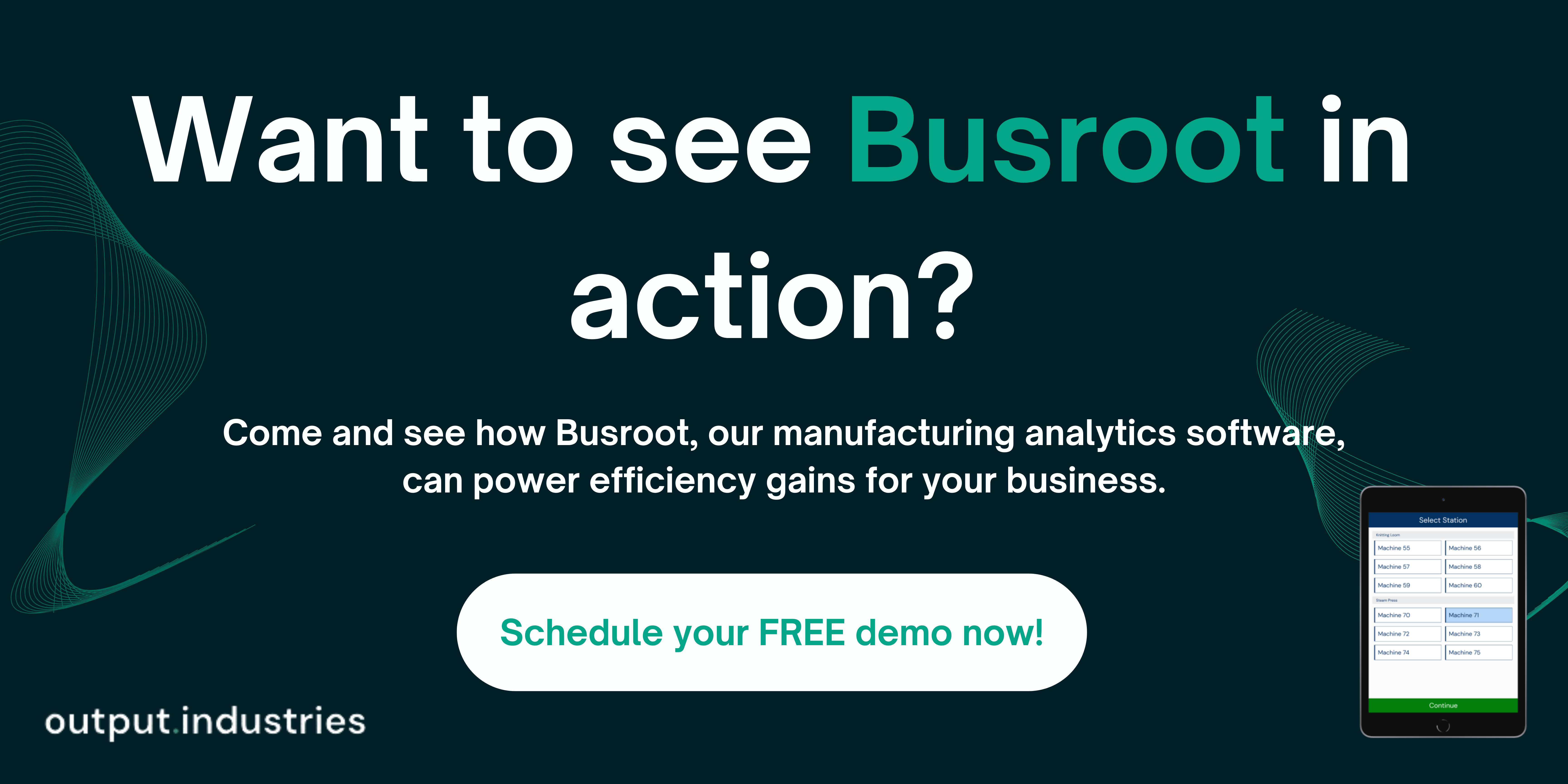Keeping tabs on energy consumption is no longer just a smart move that manufacturers can give or take—it's essential. It’s estimated that 51% of energy used in manufacturing is wasted. This is a massive amount of money and emissions going down the drain, and has big repercussions for businesses and the environment. With power being one of the biggest costs for manufacturers, and with the price of electricity not set to decrease anytime soon, it's critical to monitor consumption and reduce it wherever possible.
By actively monitoring energy use, businesses can uncover hidden inefficiencies that drain resources and add up to significant costs. Beyond just saving money, this approach helps to reduce environmental impact and become a more carbon efficient business., which helps with sustainability targets. Luckily, there are a whole host of tools that can help manufacturers to monitor and optimise their energy use, minimise waste, and enhance overall efficiency. Below, we explore the best energy monitoring software solutions for manufacturers in 2024, detailing their unique features, pricing, and what sets them apart from the competition.
1. Busroot by Output Industries
Overview:
Busroot by Output Industries is a full manufacturing analytics platform that has all the features you'd need to optimise your production and improve your operational efficiency. It excels in providing real-time energy monitoring, as it directly monitors the energy consumption of industrial assets and correlates this data to production output and asset utilisation.
It also offers Overall Equipment Effectiveness (OEE) monitoring, machine downtime tracking, cycle time tracking, and asset utilisation data. These features make Busroot a comprehensive solution for manufacturers looking to optimise both their energy consumption and overall operational efficiency.
Key Features:
- OEE Monitoring: Track the efficiency of manufacturing processes in real-time to identify bottlenecks and areas for improvement.
- Downtime Analysis: Understand the root causes of downtime and implement strategies to minimise disruptions.
- Cycle Time Tracking: Monitor cycle times to ensure that production processes are running as efficiently as possible.
- Asset Utilisation: Gain insights into how well your assets are being utilised, allowing for better resource allocation and investment decisions.
- Energy Monitoring: Detailed energy consumption data helps manufacturers optimise their energy usage, reduce waste, and lower costs.
- Customisable Dashboards: Tailor your dashboards to display the most relevant KPIs, making it easier to monitor critical data at a glance.
Pricing: Busroot is available through a tiered pricing structure, starting at £150 per machine per month. The more machines you connect, the more you save. Visit our pricing page for more information, or check out our Lighthouse Project where you could be 1 or 25 manufacturers who implement Busroot completely free of charge, thanks to funding from Innovate UK!
Best For: Manufacturers of all sizes who need a comprehensive solution that combines energy monitoring with broader manufacturing performance insights.

2. WatchWire
Overview:
WatchWire is a sophisticated energy analytics platform designed for large enterprises. It provides deep insights into energy consumption patterns, helping businesses optimise their energy use and reduce costs. WatchWire is particularly strong in its advanced reporting capabilities and carbon accounting features, making it an excellent choice for companies with complex energy management needs and companies committed to sustainability and efficiency.
Key Features:
- Carbon Accounting: Accurately track and report carbon emissions, supporting sustainability initiatives.
- Advanced Analytics: Delivers in-depth insights into energy consumption, helping to identify inefficiencies and areas for cost savings.
- Utility Bill Management: Automates the collection and analysis of utility bills, ensuring accuracy and compliance.
Pricing: Custom pricing based on the scale and specific needs of the business.
Best For: Large enterprises requiring advanced energy analytics and comprehensive reporting capabilities.
3. EnergyCap Smart Analytics (formerly Wattics)
Overview:
EnergyCAP Smart Analytics is an energy management platform known for its detailed analytics and focus on sustainability. It offers robust tools for real-time energy monitoring and carbon footprint reduction, making it ideal for businesses aiming to minimise their environmental impact. EnergyCAP smart Analytics only offers energy and emissions monitoring, so you won't be getting as many features for your money.
Key Features:
- Real-Time Monitoring: Provides up-to-the-minute data on energy usage across multiple sites.
- Carbon Footprint Tracking: Helps businesses track and reduce their carbon emissions.
- Detailed Analytics: Offers comprehensive data analysis tools that help identify energy-saving opportunities.
Pricing: Customisable pricing based on the selected features and business needs.
Best For: Environmentally conscious businesses looking for detailed insights into their energy use and carbon footprint.
4. MRI eSight
Overview:
MRI eSight is a versatile energy management system known for its seamless integration capabilities. It’s particularly well-suited for medium to large enterprises that need to integrate energy management with other operational systems, offering a comprehensive solution that enhances overall energy efficiency.
Key Features:
- Comprehensive Energy Analysis: Provides detailed insights into energy consumption, helping to identify inefficiencies and potential savings.
- Anomaly Tracking: Tracks anomalies in data and provides alerts through email
- Multilingual and Multi-Currency Support: Ideal for global enterprises needing to manage energy data across multiple regions.
- Integration with Existing Systems: Easily integrates with other operational tools, streamlining energy management processes.
Pricing: Custom pricing tailored to the specific requirements of the enterprise, request pricing quote on website.
Best For: Medium to large enterprises looking for a comprehensive energy management system with strong integration capabilities.
5. Energy Elephant
Overview:
Energy Elephant is a user-friendly energy management system designed for small to medium-sized businesses. It offers essential features that help businesses track and manage their energy consumption without the complexity of more advanced systems, making it an ideal choice for companies with straightforward energy management needs. As it's a basic system, it doesn't offer a large range of features, so wouldn't be suitable for businesses looking to scale.
Key Features:
- Automated Utility Bill Processing: Simplifies the tracking and validation of energy bills.
- Sustainability Tracking: Provides tools for monitoring energy usage against sustainability goals.
- Benchmarking: Allows businesses to compare their energy use against industry standards.
Pricing: Plans start at €13.80 per metre, and reduce as you increase data points.
Best For: Small to medium-sized businesses needing an easy-to-use, cost-effective energy management solution.
6. JadeTrack
Overview:
JadeTrack is a specialised energy management platform focusing on real-time monitoring and sustainability. It’s designed to provide immediate insights into energy usage, allowing businesses to make quick, effective decisions to optimise their energy consumption. Whilst JadeTrack offers basic advice on energy usage, it's main focus is on utility bill management, so it isn't the best options for companies looking to dive deep into their usage data.
Key Features:
- Real-Time Monitoring: Delivers instant data on energy use, helping to quickly identify and address inefficiencies.
- Sustainability Tracking: Monitors progress towards sustainability goals, including greenhouse gas emissions.
- ENERGY STAR Benchmarking: Enables businesses to benchmark their energy use against ENERGY STAR standards.
Pricing: Tier-based pricing structure depending on the business size and needs.
Best For: Businesses that prioritise real-time insights and sustainability in their energy management practices.
Choosing the right Energy Monitoring Software for your needs
Selecting the right energy monitoring software is a critical decision that can greatly impact your manufacturing operations. Here are some key factors to consider to ensure you choose a solution that aligns with your specific needs:
1. Scalability
Your business may grow over time, and your energy monitoring needs will likely evolve as well. It's important to choose software that can scale with your operations, whether you're managing a single facility or multiple sites across different locations. Look for solutions that offer flexibility in terms of the number of monitored points and the ability to handle increasing data volumes without compromising performance.
2. Integration Capabilities
Seamless integration with your existing systems, such as ERP, SCADA, or building management systems, is crucial for maximising the benefits of energy monitoring software. Ensure the software can easily connect with your current infrastructure to enable smooth data flow and comprehensive reporting.
3. Real-Time Monitoring and Alerts
Real-time monitoring allows you to track energy consumption as it happens, giving you the ability to react swiftly to any anomalies or inefficiencies. Additionally, consider software that offers automated alerts for unusual patterns or exceeding predefined thresholds, helping you address issues before they escalate.
4. Data Analytics and Reporting
Advanced analytics are essential for turning raw data into actionable insights. Look for software that offers robust data analysis tools, customisable dashboards, and detailed reporting features. These capabilities will help you understand energy usage trends, forecast future consumption, and identify opportunities for improvement.
5. User-Friendliness
A user-friendly interface is vital for ensuring that your team can quickly adopt and effectively use the software. Consider solutions that offer intuitive navigation, easy-to-understand data visualisation, and customisable views that allow users to focus on the most relevant information for their roles.
6. Cost and ROI
While the initial cost of the software is an important consideration, it’s equally important to evaluate the potential return on investment (ROI). Consider how the software can help you reduce energy costs, improve operational efficiency, and achieve long-term savings. Look for transparent pricing models and consider whether the features offered justify the investment.
7. Customer Support and Training
Reliable customer support and comprehensive training resources are crucial, especially during the initial setup and implementation phases. Ensure the software provider offers strong support services, including technical assistance, training programs, and access to a knowledgeable support team that can help you get the most out of the software.
By carefully evaluating the softwares on the market, you can choose an energy monitoring solution that not only meets your current needs but also supports your long-term operational goals.
If you'd like to learn more about how Busroot can optimise your energy usage and improve your overall operational efficiency, get in touch now to schedule a demo!




